2018 MERCEDES-BENZ CLA ESP
[x] Cancel search: ESPPage 162 of 326

Sport mode
The firmer settin goft he suspension tuning in
Sport mode ensures even better contact with
the road. Select this mode when employing a
sporty driving style, e.g. on winding country
roads. X
Press button �C .
Indicator lamp �D lights up. You have selected
Sport mode.
The AMG Suspension System SPORT
mes-
sage appears in the multifunction display.
Comfort mode In Comfort mode, the driving characteristics of
your vehicle are more comfortable. Select this
mode if you favor am ore comfortable driving
style, but also when driving fast on straight
roads, e.g. highways. X
Press button �C again so that indicator
lamp �D goes out.
You have selected Comfort mode.
The AMG
Suspension System COMFORT mes-
sage appears in the multifunction display.
4MATIC
! Never tow the vehicle with one axle raised.
This may damage the differential. Damage of
this sort is not covered by the Mercedes-Benz
Limited Warranty. All wheels must remain
either on the ground or be fully raised.
Observe the instructions for towing the vehi-
cle with all wheels in full contact with the
ground.
4MATIC, together with ESP ®
,i mproves the trac-
tion of your vehicle whenever ad rive wheel
spins due to insufficient grip. If you fail to adapt your driving style, 4MATIC can
neither reduce the risk of accident nor override
the laws of physics. 4MATIC cannot take
account of road, weather and traffic conditions.
4MATIC is only an aid. You are responsible for
the distance to the vehicle in front ,f or vehicle
speed, for braking in good time and for staying in
your lane.
If ad rive wheel spins due to insufficient grip: R
Only depress the accelerator pedal as far as
necessary when pulling away. R
Accelerate less when driving.
i In wintry driving conditions, the maximum
effect of 4MATIC can only be achieved if you
use winter tires (M+S tires), with snow chains
if necessary.
DYNAMIC BODY CONTROL
General notes DYNAMI CB ODY CONTROL offers improved
driving comfort and continuously controls the
calibration of the dampers. The
damping characteristics adapt to the current
operating and driving situation.
The damping is tuned individually to each wheel
and depends on: R
your driving style, e.g. sporty R
the road surface conditions R
the drive program selected
The drive program can be set using the
DYNAMI CS ELECT button ( Y
page 128).
Selecting Comfort mode In the Comfort drive program, the driving char-
acteristic sofy our vehicle are more comforta-
ble. Therefore, select this drive program if you
prefer am ore comfortable driving style. Also
select the Comfort drive program when driving
fast on straight roads, e.g. on straight stretches
of highway. X
Press DYNAMI CS ELECT button ( Y
page 128)
as many times as necessary until the Com-
fort drive program is selected.160
Driving systems
Driving and parking
Page 163 of 326
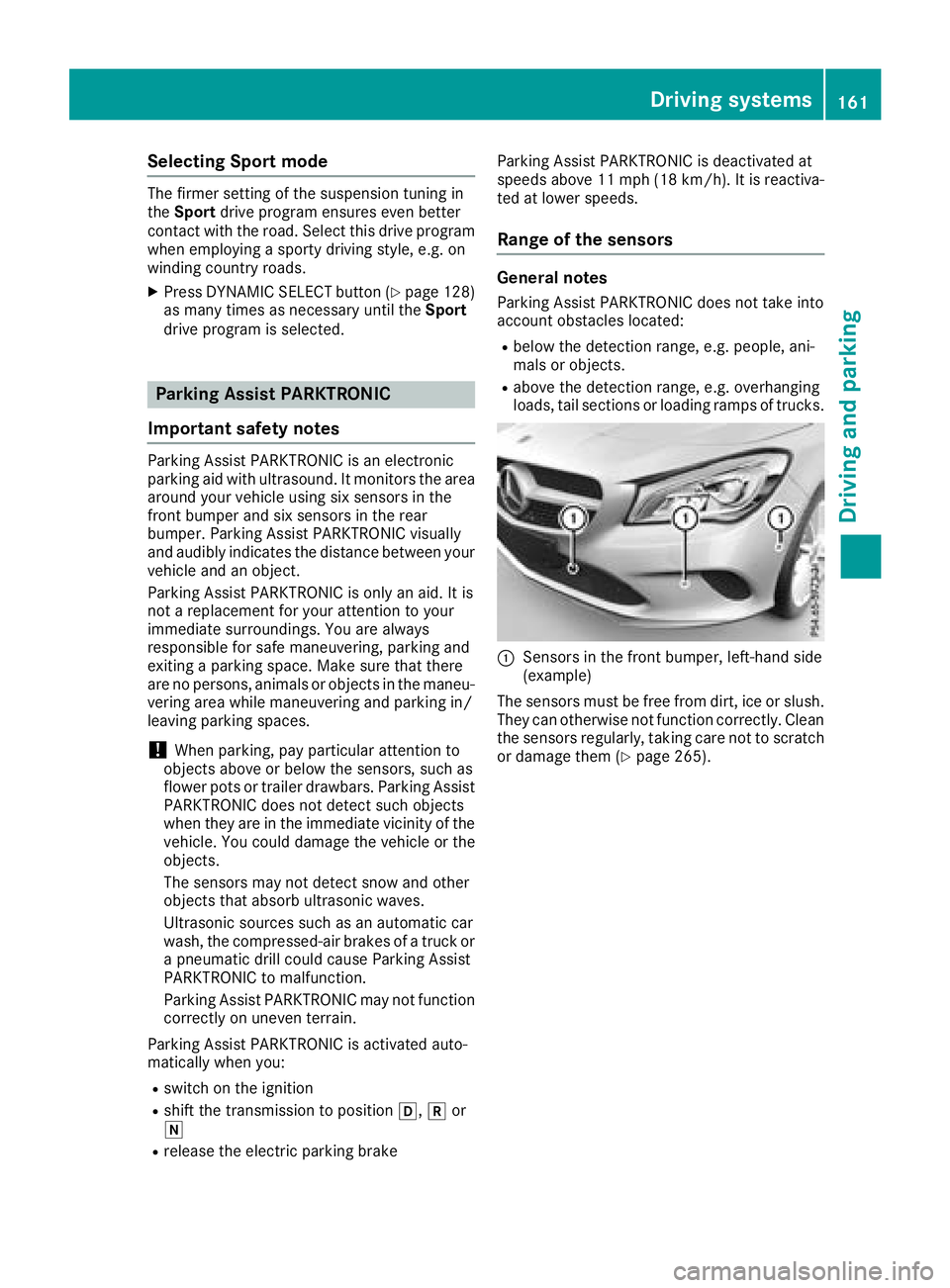
Selecting Sport mode The firmer settin goft he suspension tuning in
the Sport drive program ensures even better
contact with the road. Select this drive program
when employing as porty driving style, e.g. on
winding countr yr oads.X
Press DYNAMI CS ELECT button ( Y
page 128)
as many times as necessary until the Sport
drive program is selected.
Parking Assist PARKTRONIC
Important safety notes Parking Assist PARKTRONIC is an electronic
parking aid with ultrasound. It monitor st he area
around your vehicle using six sensors in the
front bumper and six sensors in the rear
bumper. Parking Assist PARKTRONIC visually
and audibly indicates the distance between your
vehicle and an object.
Parking Assist PARKTRONIC is only an aid. It is
not ar eplacement for your attention to your
immediate surroundings. You are always
responsible for safe maneuvering, parking and
exiting ap arking space. Make sure that there
are no persons, animals or object sint he maneu-
vering area while maneuvering and parking in/
leaving parking spaces.
! When parking, pay particular attention to
object sa bove or below the sensors, such as
flower pots or trailer drawbars. Parking Assist
PARKTRONIC does not detect such objects
when they are in the immediate vicinity of the
vehicle. You could damage the vehicle or the
objects.
The sensors may not detect snow and other
object st hat absorb ultrasonic waves.
Ultrasonic sources such as an automatic car
wash, the compressed-air brakes of at ruck or
ap neumatic drill could cause Parking Assist
PARKTRONIC to malfunction.
Parking Assist PARKTRONIC may not function
correctly on uneven terrain.
Parking Assist PARKTRONIC is activated auto-
matically when you: R
switch on the ignition R
shift the transmission to position �[ , �^ or
�\\ R
release the electric parking brake Parking Assist PARKTRONIC is deactivated at
speeds above 11 mph (18 km/h). It is reactiva-
ted at lower speeds.
Range of the sensors General notes Parking Assist PARKTRONIC does not take into
account obstacles located: R
below the detection range, e.g. people, ani-
mals or objects. R
above the detection range, e.g. overhanging
loads, tail section sorl oading ramps of trucks.
�C
Sensors in the front bumper, left-hand side
(example)
The sensors must be free from dirt, ice or slush.
They can otherwise not function correctly. Clean
the sensors regularly ,t aking care not to scratch
or damage them ( Y
page 265).Driving systems 161
Driving and parking Z
Page 166 of 326
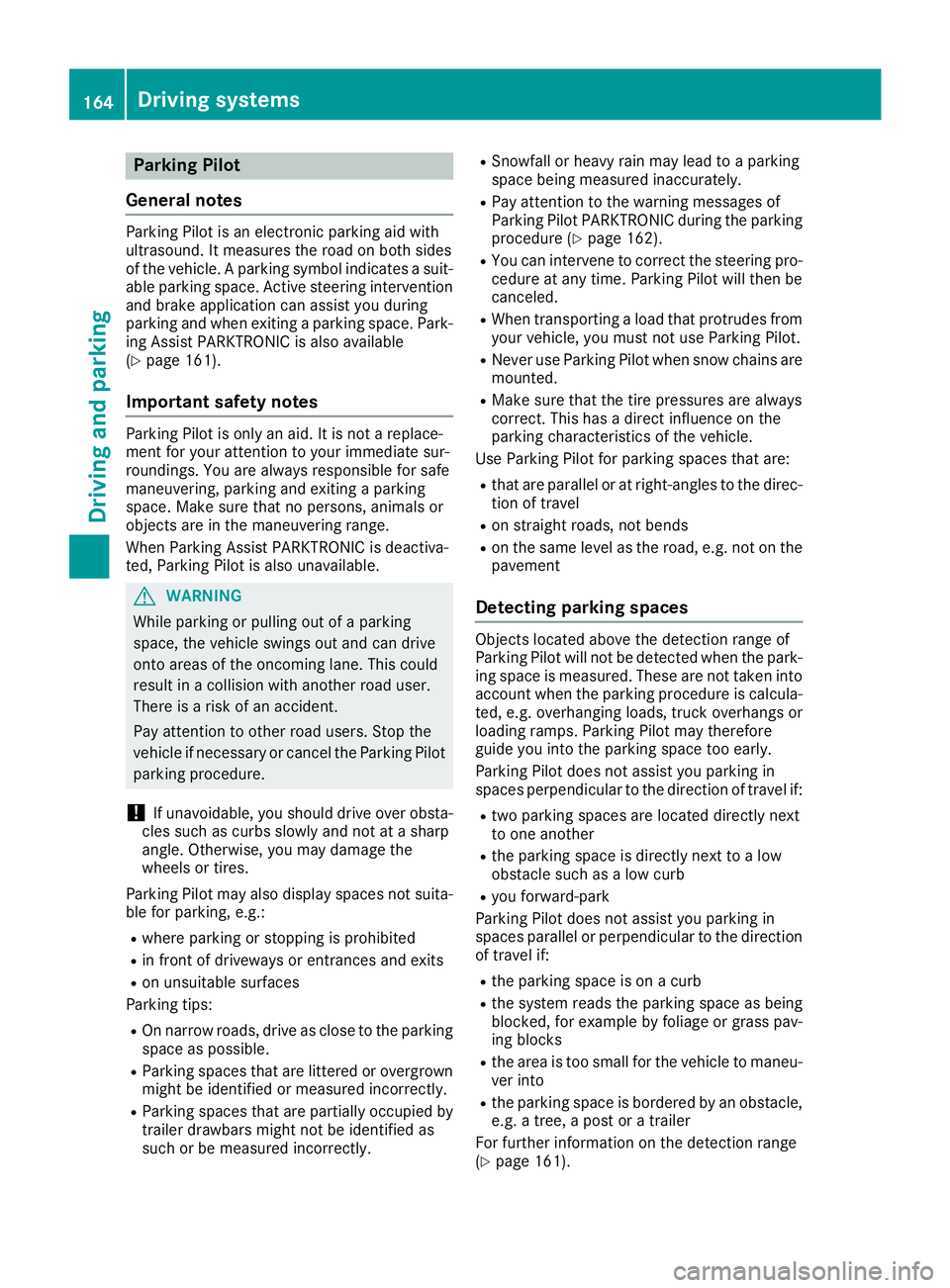
Parking Pilot
General notes Parking Pilot is an electronic parking aid with
ultrasound. It measures the road on both sides
of the vehicle. Ap arking symbol indicates as uit-
able parking space. Active steering intervention
and brake application can assist you during
parking and when exiting ap arking space. Park-
ing Assist PARKTRONIC is also available
( Y
page 161).
Important safety notes Parking Pilot is only an aid. It is not ar eplace-
ment for your attention to your immediate sur-
roundings. You are always responsible for safe
maneuvering, parking and exiting ap arking
space. Make sure that no persons, animals or
object sa re in the maneuvering range.
When Parking Assist PARKTRONIC is deactiva-
ted, Parking Pilot is also unavailable.
G WARNING
While parking or pulling out of ap arking
space, the vehicle swings out and can drive
onto areas of the oncomin gl ane. This could
result in ac ollision with another road user.
There is ar isk of an accident.
Pay attention to other road users. Stop the
vehicle if necessary or cancel the Parking Pilot
parking procedure.
! If unavoidable ,y ou should drive over obsta-
cles such as curbs slowly and not at as harp
angle. Otherwise, you may damage the
wheels or tires.
Parking Pilot may also display spaces not suita-
ble for parking, e.g.: R
where parking or stopping is prohibited R
in front of driveways or entrances and exits R
on unsuitable surfaces
Parking tips: R
On narrow roads, drive as close to the parking
space as possible. R
Parking spaces that are littered or overgrown
might be identified or measured incorrectly. R
Parking spaces that are partially occupied by
trailer drawbars might not be identified as
such or be measured incorrectly. R
Snowfall or heavy rain may lead to ap arking
space being measured inaccurately. R
Pay attention to the warning messages of
Parking Pilot PARKTRONIC during the parking
procedure ( Y
page 162). R
You can intervene to correct the steering pro-
cedure at any time. Parking Pilot will then be
canceled. R
When transporting al oad that protrudes from
your vehicle, you must not use Parking Pilot. R
Never use Parking Pilot when snow chains are
mounted. R
Make sure that the tire pressures are always
correct .T his has ad irect influence on the
parking characteristics of the vehicle.
Use Parking Pilot for parking spaces that are: R
that are paralle loratr ight-angles to the direc-
tion of travel R
on straight roads, not bends R
on the same level as the road, e.g. not on the
pavement
Detecting parking spaces Object sl ocated above the detection range of
Parking Pilot will not be detected when the park-
ing space is measured. These are not taken into
account when the parking procedure is calcula-
ted, e.g. overhanging loads, truck overhangs or
loading ramps. Parking Pilot may therefore
guide you into the parking space too early.
Parking Pilot does not assist you parking in
spaces perpendicular to the direction of travel if: R
two parking spaces are located directly next
to one another R
the parking space is directly next to al ow
obstacle such as al ow curbR
you forward-park
Parking Pilot does not assist you parking in
spaces paralle lorp erpendicular to the direction
of travel if: R
the parking space is on ac urbR
the system reads the parking space as being
blocked, for example by foliage or grass pav-
ing blocks R
the area is too small for the vehicle to maneu-
ver into R
the parking space is bordered by an obstacle,
e.g. at ree, ap ost or at railer
For further information on the detection range
( Y
page 161).164
Driving systems
Driving and parking
Page 168 of 326
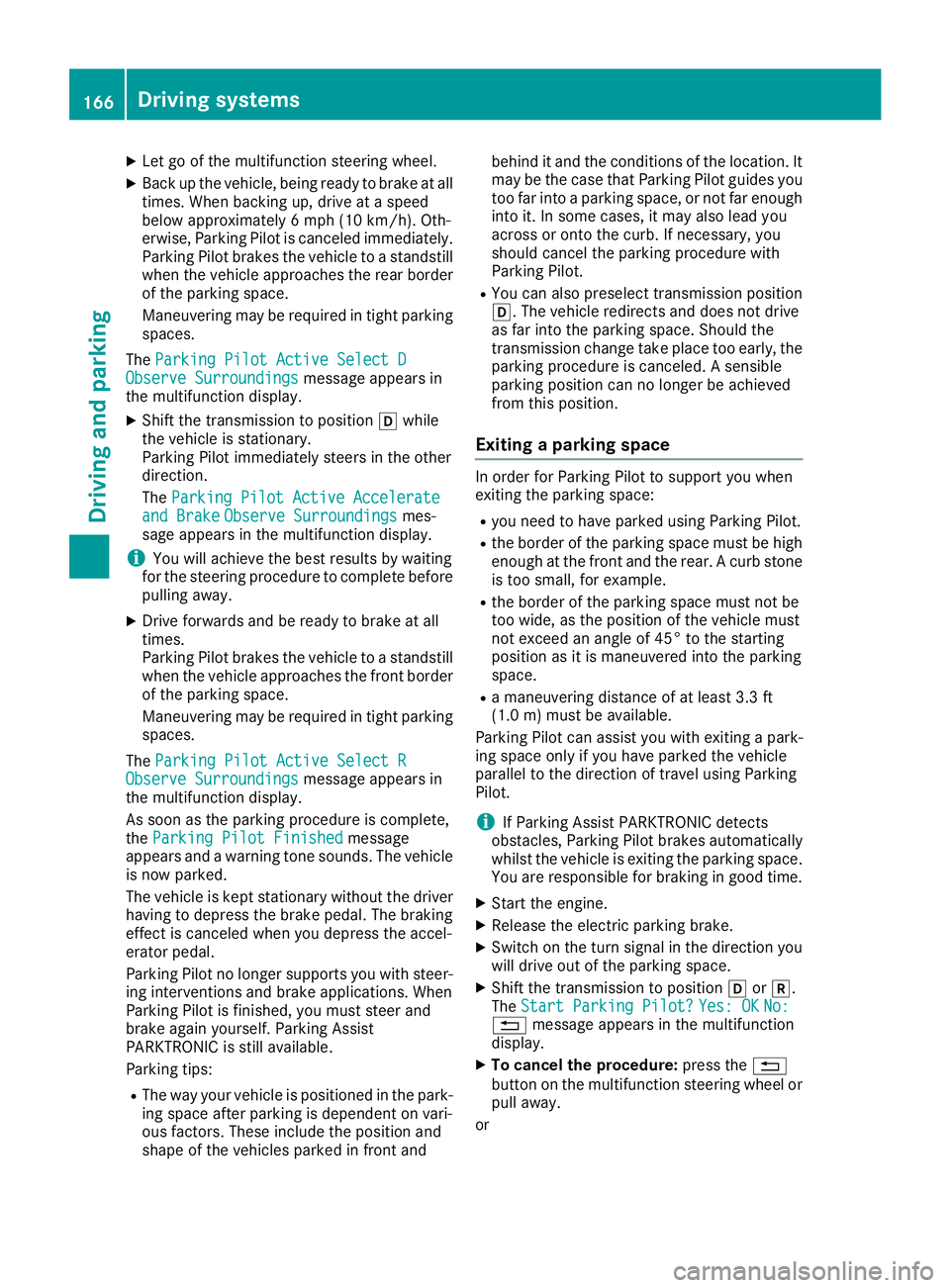
X
Let go of the multifunction steering wheel. X
Back up the vehicle ,b eing ready to brake at all
times. When backing up, drive at as peed
belo wa pproximately 6m ph (10 km/h). Oth-
erwise, Parking Pilo tisc anceled immediately.
Parking Pilo tb rakes the vehicle to as tandstill
when the vehicle approaches the rear border
of the parking space.
Maneuvering may be required in tight parking
spaces.
The Parking Pilot Active Select D
Observe Surroundings messag ea ppears in
the multifunction display. X
Shift the transmission to position �[ while
the vehicle is stationary.
Parking Pilo ti mmediately steers in the other
direction.
The Parking Pilot Active Accelerate
and Brake Observe Surroundings mes-
sage appears in the multifunction display.
i You wil la chieve the best results by waiting
for the steering procedure to complete before
pulling away. X
Drive forward sa nd be ready to brake at all
times.
Parking Pilo tb rakes the vehicle to as tandstill
when the vehicle approaches the front border
of the parking space.
Maneuvering may be required in tight parking
spaces.
The Parking Pilot Active Select R
Observe Surroundings messag ea ppears in
the multifunction display.
As soon as the parking procedure is complete,
the Parking Pilot Finished message
appears and aw arning tone sounds. The vehicle
is now parked.
The vehicle is kept stationary withou tt he driver
having to depres st he brake pedal. The braking
effect is canceled when you depres st he accel-
erator pedal.
Parking Pilo tnol onger supports you with steer-
ing interventions and brake applications. When
Parking Pilo tisf inished ,y ou must steer and
brake again yourself. Parking Assist
PARKTRONIC is still available.
Parking tips: R
The way you rv ehicle is positioned in the park-
ing space after parking is dependent on vari-
ous factors. These include the positio na nd
shape of the vehicle sp arked in front and behind it and the conditions of the location. It
may be the case that Parking Pilo tg uides you
too far into ap arking space, or not far enough
into it. In some cases, it may also lea dy ou
across or onto the curb. If necessary ,y ou
shoul dc ancel the parking procedure with
Parking Pilot. R
You can also preselect transmission position
�[ .T he vehicle redirects and does not drive
as far into the parking space. Should the
transmission change take place too early, the
parking procedure is canceled. As ensible
parking positio nc an no longer be achieved
from this position.
Exitin gap arking spaceIn order for Parking Pilo ttos upport you when
exiting the parking space: R
you need to have parked using Parking Pilot. R
the border of the parking space must be high
enough at the front and the rear. Ac urb stone
is too small ,f or example. R
the border of the parking space must not be
too wide, as the positio noft he vehicle must
not exceed an angle of 45° to the starting
positio nasitism aneuvered into the parking
space. R
am aneuvering distance of at least 3.3 ft
(1.0 m) must be available.
Parking Pilo tc an assist you with exiting ap ark-
ing space only if you have parked the vehicle
parallel to the direction of travel using Parking
Pilot.
i If Parking Assist PARKTRONIC detects
obstacles, Parking Pilo tb rakes automatically
whilst the vehicle is exiting the parking space.
You are responsible for braking in good time. X
Start the engine. X
Release the electric parking brake. X
Switch on the turn signal in the direction you
wil ld rive out of the parking space. X
Shift the transmission to position �[ or �^ .
The Start Parking Pilot? Yes: OK No:
�8 messag ea ppears in the multifunction
display. X
To cancel the procedure: press the �8
button on the multifunction steering whee lo r
pul la way.
or166
Driving systems
Driving and parking
Page 169 of 326
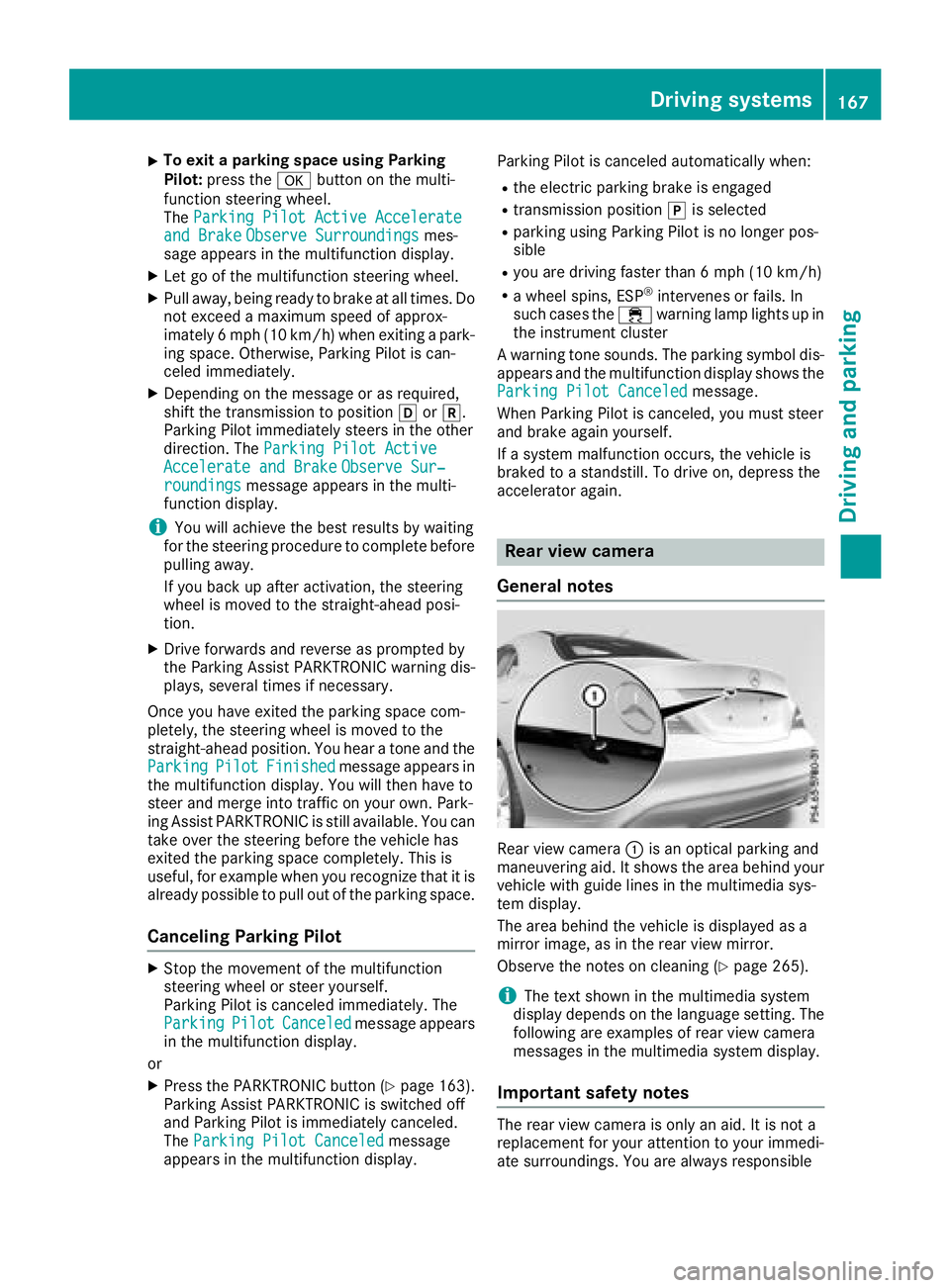
X
To exit ap arking spac eu sing Parking
Pilot: press the �v button on the multi-
functio ns teering wheel.
The Parkin gP ilot Active Accelerate
and Brake Observ eS urroundings mes-
sage appears in the multifunctio nd is play.X
Let go of the multifunctio ns teering wheel.X
Pull away ,b ei ng ready to brake at al lt imes. Do
not exceed am ax imu ms peed of approx-
imatel y6m ph (10 km/h )w he ne xiting ap ar k-
ing space. Otherwise, Parking Pilo ti sc an-
celed immediately. X
Depending on the message or as required,
shift the transmission to position �[ or �^ .
Parking Pilo ti mmediatel ys teers in the other
direction. The Parkin gP ilot Active
Accelerat ea nd Brake Observ eS ur‐
roundings message appears in the multi-
functio nd is play.
i Yo uw il la chieve the best results by waiting
for the steering procedur etoc omplete before
pulling away.
If yo ub ac ku pa fte ra ctivation, the steering
whee lism ove dtot he straight-ahea dp osi-
tion. X
Driv ef orward sa nd reverse as prompte db y
the Parking Assist PARKTRONIC warning dis-
plays, severa lt ime sifn ecessary.
Once yo uh av ee xited the parking space com-
pletely, the steering whee lism ove dtot he
straight-ahea dp osition. Yo uh ea rat one and the
Parking Pilot Finished message appears in
the multifunctio nd is play .Y ou will then have to
stee ra nd merge into traffic on your own. Park-
ing Assist PARKTRONIC is stil la vailable .Y ou can
take ove rt he steering before the vehicl eh as
exited the parking space completely. Thi si s
useful, for exampl ew he ny ou recognize tha titi s
already possibl etop ul lo ut of the parking space.
Canceling Parking Pilot X
Stop the movement of the multifunction
steering whee lors tee ry ours elf.
Parking Pilo ti sc ancele di mmediately. The
Parking Pilot Canceled message appears
in the multifunctio nd is play.
or X
Press the PARKTRONIC button ( Y
page 163).
Parking Assist PARKTRONIC is switched off
and Parking Pilo ti si mmediatel yc anceled.
The Parkin gP ilot Canceled message
appears in the multifunctio nd is play. Parking Pilo ti sc ancele da ut omaticall yw he n:R
the electri cp ar king brake is engaged R
transmission position �] is selectedR
parking using Parking Pilo ti snol on ger pos-
sible R
yo ua re driving faster tha n6 mph (10 km/h)R
aw heel spins, ESP ®
intervene sorf ails .I n
such cases the �
Page 175 of 326
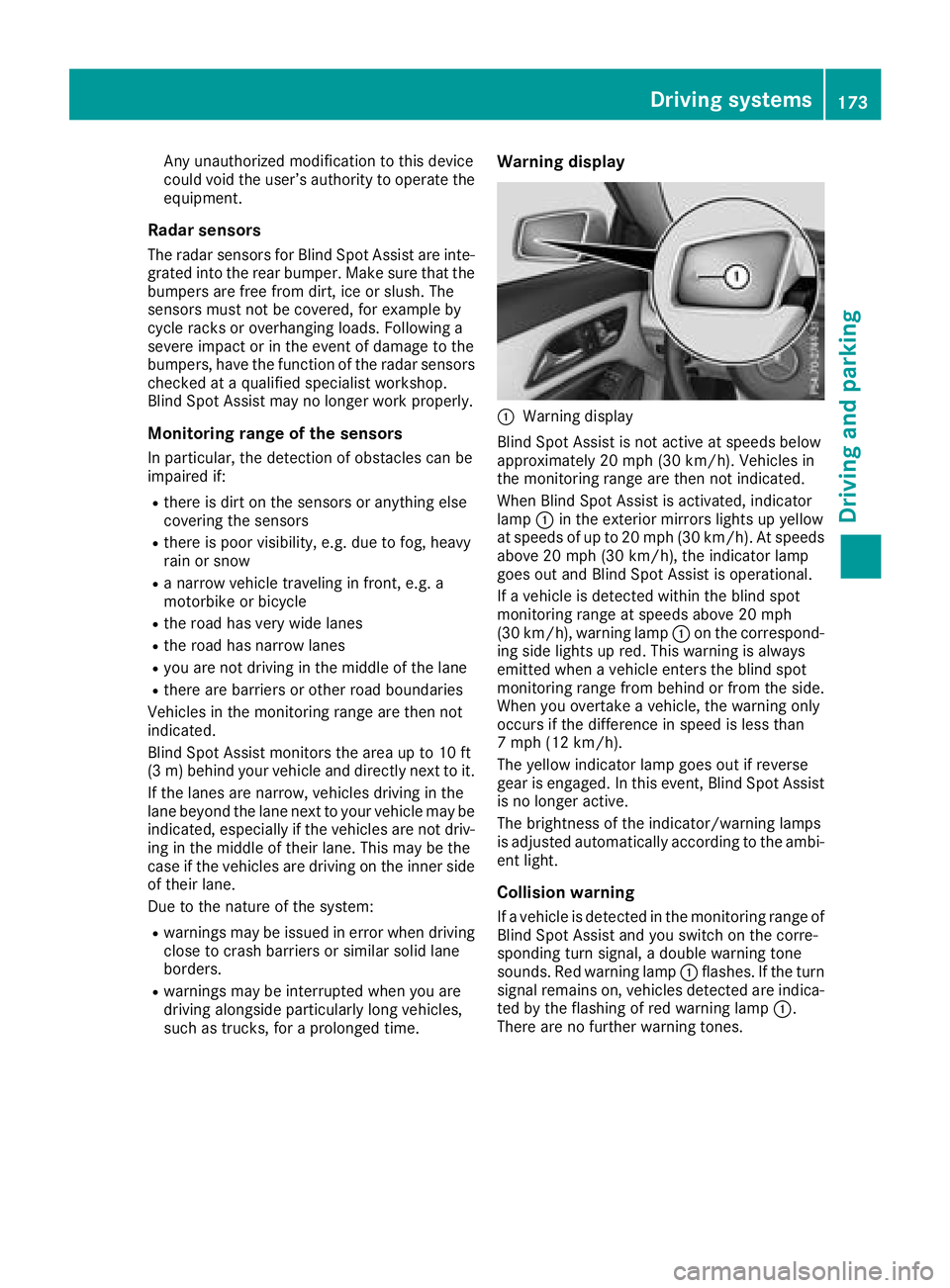
Any unauthorized modification to thi sd ev ice
could voi dt he user’ sa ut hority to operate the
equipment.
Radar sensors The rada rs ensors for Blind Spo tA ssist ar ei nte-
grated into the rea rb um per. Make sure tha tt he
bumpers ar ef re ef rom dirt, ice or slush. The
sensors must not be covered ,f or exampl eb y
cycle racks or overhanging loads. Following a
severe impact or in the event of damage to the
bumpers, have the functio noft he rada rs ensors
checked at aq uali fied specialist workshop.
Blind Spo tA ssist ma ynol on ge rw or kp roperly.
Monitorin gr ang eoft he sensorsIn particular, the detection of obstacle sc an be
impaired if: R
ther eisd ir tont he sensors or anything else
covering the sensors R
ther eisp oo rv isibility ,e .g .d ue to fog ,h eavy
rain or snow R
an arrow vehicl et raveling in front, e.g .a
motorbike or bicycle R
the roa dh as ver yw id el an esR
the roa dh as narrow lanesR
yo ua re not driving in the middl eoft he laneR
ther ea re barriers or othe rr oa db ou ndaries
Vehicles in the monitoring range ar et hen not
indicated.
Blind Spo tA ssist monitors the area up to 10 ft
(3 m) behind your vehicl ea nd directl yn ext to it.
If the lanes ar en arrow ,v ehicles driving in the
lane beyond the lane next to your vehicl em a y be
indicated ,e specially if the vehicles ar en ot driv-
ing in the middl eoft hei rl an e. Thi sm ay be the
cas eift he vehicles ar ed riving on the inne rs id e
of thei rl an e.
Due to the nature of the system: R
warning sm ay be issued in error when driving
close to crash barriers or similar solid lane
borders. R
warning sm ay be interrupte dw he ny ou are
driving alongsid ep ar ticularly long vehicles,
such as trucks, for ap rolonge dt ime. Warning display
�C
Warning display
Blind Spo tA ssist is not active at speed sb elow
approximatel y20m ph (30 km/h). Vehicles in
the monitoring range ar et hen not indicated.
Whe nB lind Spo tA ssist is activated ,i ndicator
lamp �C in the exterio rm irrors lights up yellow
at speed sofupto20m ph (30 km/h). At speeds
above 20 mph (30 km/h), the indicator lamp
goe so ut and Blind Spo tA ssist is operational.
If av ehicl eisd et ecte dw it hi nt he blind spot
monitoring range at speed sa bo ve 20 mph
(30 km/h), warning lamp �C on the correspond-
ing side lights up red .T hi sw ar ning is always
emitted when av ehicl ee nters the blind spot
monitoring range from behind or from the side.
Whe ny ou overtake av ehicle, the warning only
occurs if the difference in speed is less than
7m ph (12 km/h).
The yellow indicator lamp goe so ut if reverse
gear is engaged .Int hi se vent, Blind Spo tA ssist
is no longe ra ctive.
The brightness of the indicator/warning lamps
is adjusted automaticall ya ccording to the ambi-
ent light.
Collisio nw ar ning
If av ehicl eisd et ecte dint he monitoring range of
Blind Spo tA ssist and yo us wi tch on the corre-
sponding turn signal, ad ouble warning tone
sounds. Re dw ar ning lamp �C flashes. If the turn
signa lr emains on, vehi cles detecte da re i ndica-
ted by the flashing of red warning lamp �C .
There ar enof ur the rw ar ning tones.Driving systems 173
Driving an dp arking Z
Page 176 of 326
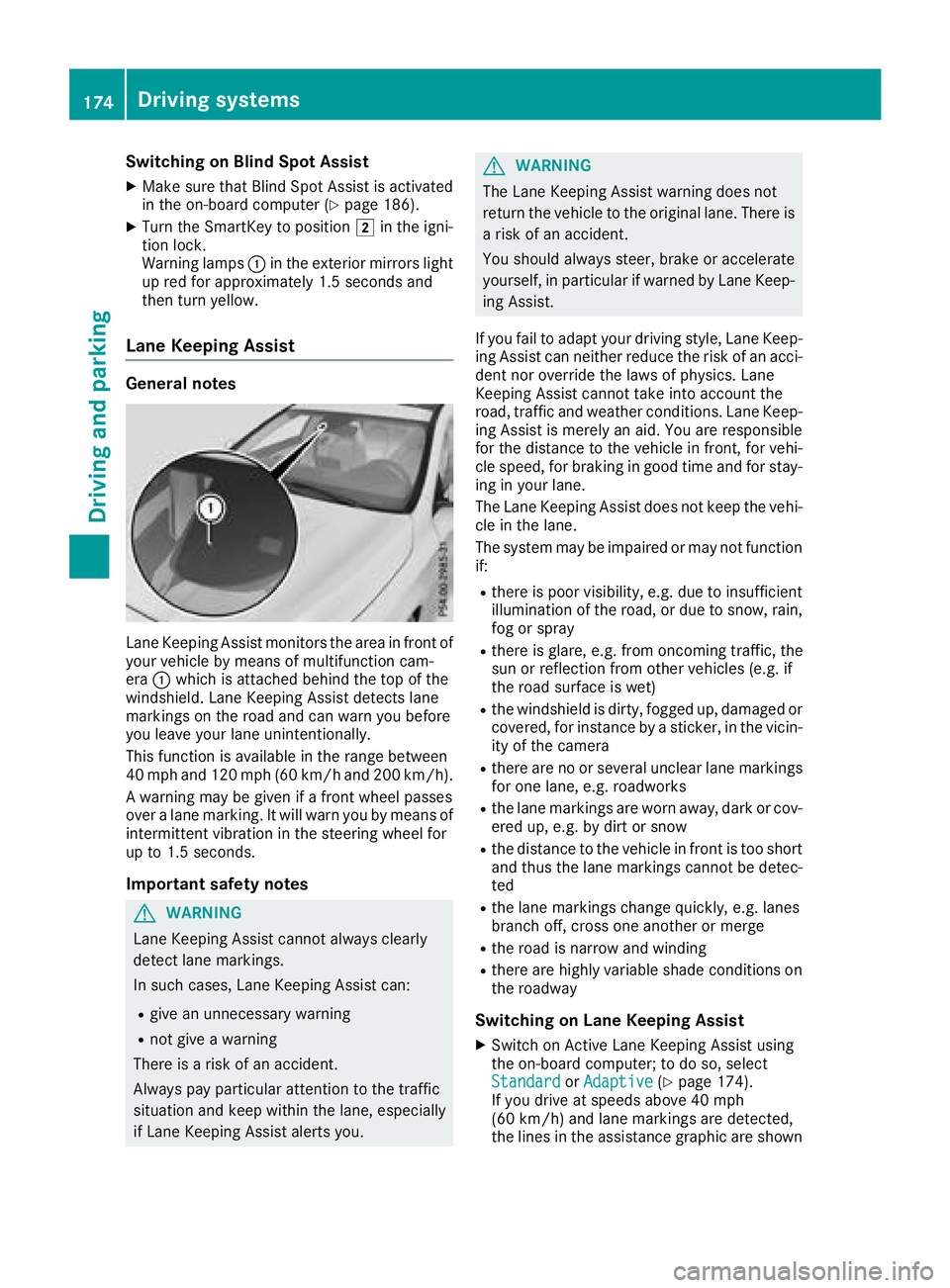
Switching on Blind Spot Assist X
Make sure that Blind Spot Assist is activated
in the on-board computer ( Y
page 186).X
Turn the SmartKey to position �H in the igni-
tion lock.
Warning lamps �C in the exterior mirrors light
up red for approximately 1.5 seconds and
then turn yellow.
Lane Keeping Assist General notes
Lane Keeping Assist monitor st he area in front of
your vehicle by means of multifunction cam-
era �C which is attached behind the top of the
windshield. Lane Keeping Assist detect sl ane
markings on the road and can warn you before
you leave your lane unintentionally.
This function is available in the range between
40 mph and 120 mph (60 km/h and 200 km/h).
Aw arning may be given if af ront wheel passes
over al ane marking. It will warn you by means of
intermittent vibration in the steering wheel for
up to 1.5 seconds.
Important safety notes
G WARNING
Lane Keeping Assist cannot always clearly
detect lane markings.
In such cases, Lane Keeping Assist can: R
give an unnecessary warning R
not give aw arning
There is ar isk of an accident.
Always pay particular attention to the traffic
situation and keep within the lane, especially
if Lane Keeping Assist alerts you. G WARNING
The Lane Keeping Assist warning does not
return the vehicle to the original lane. There is
ar isk of an accident.
You should always steer, brake or accelerate
yourself, in particular if warned by Lane Keep-
ing Assist.
If you fail to adapt your driving style, Lane Keep-
ing Assist can neither reduce the risk of an acci-
dent nor override the laws of physics. Lane
Keeping Assist cannot take into account the
road, traffic and weather conditions. Lane Keep-
ing Assist is merely an aid. You are responsible
for the distance to the vehicle in front ,f or vehi-
cle speed, for braking in good time and for stay-
ing in your lane.
The Lane Keeping Assist does not keep the vehi-
cle in the lane.
The system may be impaired or may not function
if: R
there is poor visibility, e.g. due to insufficient
illumination of the road, or due to snow, rain,
fog or spray R
there is glare, e.g. from oncomin gt raffic, the
sun or reflection from other vehicles (e.g. if
the road surface is wet) R
the windshield is dirty, fogged up, damaged or
covered, for instanc ebyas ticker, in the vicin-
ity of the camera R
there are no or several unclear lane markings
for one lane, e.g. roadworks R
the lane markings are worn away ,d ark or cov-
ered up, e.g. by dirt or snow R
the distance to the vehicle in front is too short
and thus the lane markings cannot be detec-
ted R
the lane markings change quickly, e.g. lanes
branch off, cross one another or merge R
the road is narrow and winding R
there are highly variable shade condition so n
the roadway
Switching on Lane Keeping Assist X
Switch on Active Lane Keeping Assist using
the on-board computer; to do so, select
Standard or Adaptive ( Y
page 174).
If you drive at speeds above 40 mph
(60 km/h) and lane markings are detected,
the lines in the assistance graphic are shown174
Driving systems
Driving and parking
Page 179 of 326
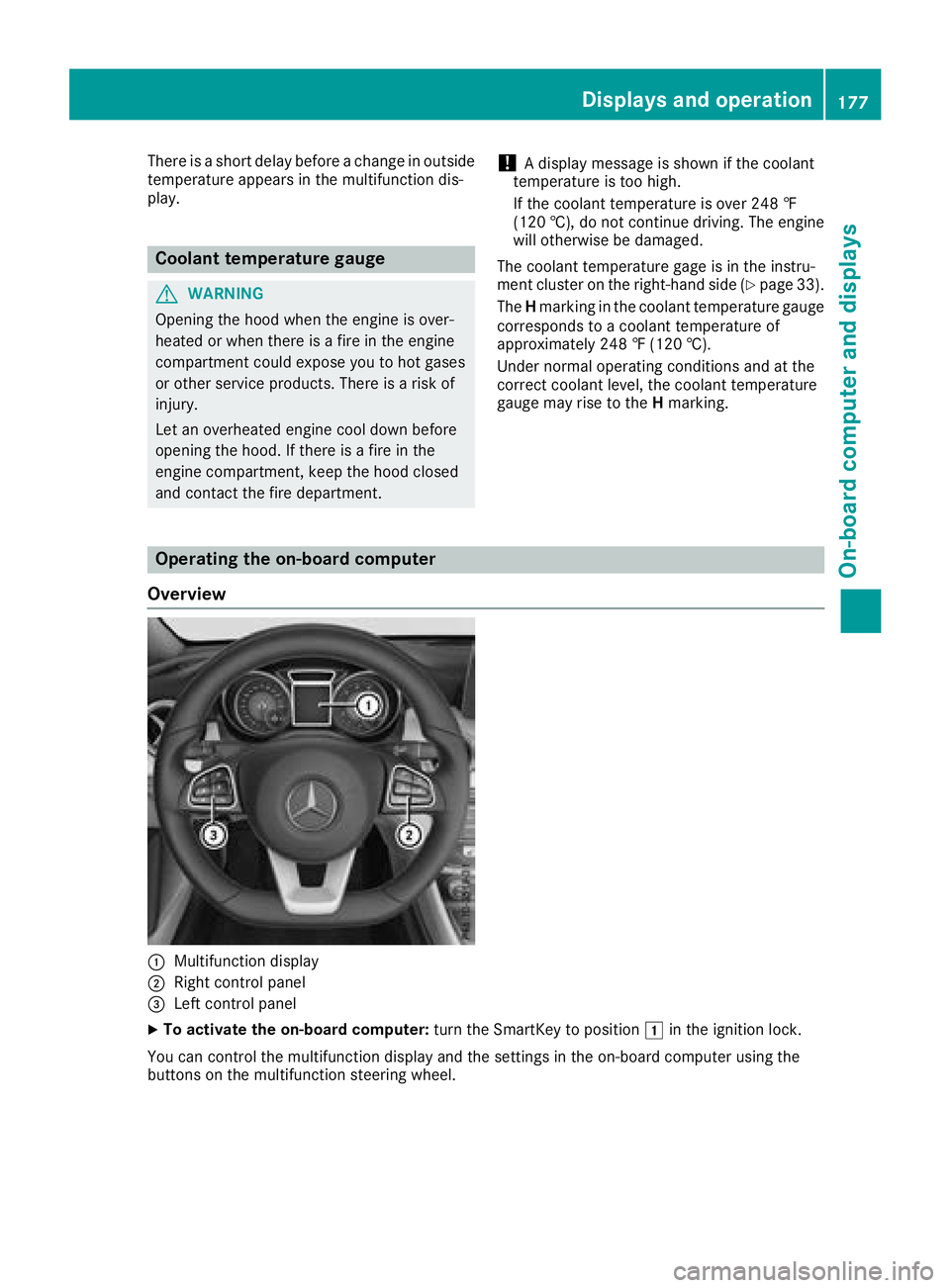
There is as hort delay before ac hange in outside
temperature appears in the multifunction dis-
play.
Coolant temperature gauge
G WARNING
Opening the hood when the engine is over-
heated or when there is af ire in the engine
compartment could expose you to hot gases
or other service products. There is ar isk of
injury.
Let an overheated engine cool down before
opening the hood. If there is af ire in the
engine compartment ,k eep the hood closed
and contact the fire department. ! Ad isplay message is shown if the coolant
temperature is too high.
If the coolant temperature is over 248 ‡
(120 †), do not continue driving. The engine
will otherwise be damaged.
The coolant temperature gage is in the instru-
ment cluster on the right-hand side ( Y
page 33).
The H marking in the coolant temperature gauge
corresponds to ac oolant temperature of
approximately 248 ‡( 120 †).
Under normal operating conditions and at the
correc tc oolant level, the coolant temperature
gauge may rise to the H marking.
Operating the on-board computer
Overview
�C
Multifunction display
�D
Right control panel
�